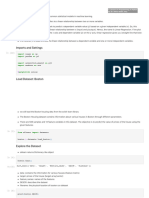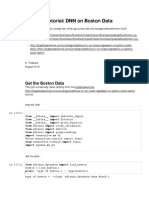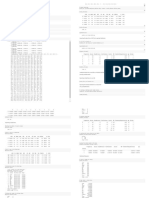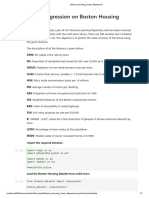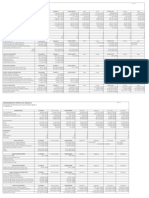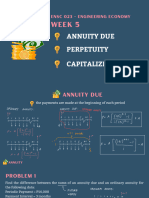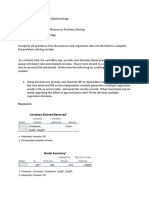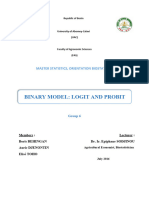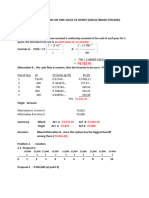In [1]:
# Import libraries and create alias for Pandas, Numpy and Matplotlib import pandas as pd
import numpy as np
import matplotlib.pyplot as plt
In [2]:
# Create a Dataframe with Dependent Variable(x) and independent variable y. x=np.array([95,85,80,70,60])
y=np.array([85,95,70,65,70])
In [3]:
# Create Linear Regression Model using Polyfit Function: model= np.polyfit(x, y,
1)
In [4]:
# Observe the coefficients of the model.
model
array([ 0.64383562,
26.78082192])
Out[4]:
In [5]:
# Predict the Y value for X and observe the output. predict =
np.poly1d(model)
predict(65)
68.63013698630
137
Out[5]:
In [6]:
# Predict the y_pred for all values of x. y_pred = predict(x)
y_pred
array([87.94520548, 81.50684932, 78.28767123,
71.84931507, 65.4109589 ])
Out[6]:
In [7]:
# Evaluate the performance of Model (R-Suare) from
sklearn.metrics import r2_score
r2_score(y, y_pred)
0.4803218090889
322
Out[7]:
In [8]:
# Plotting the linear regression model y_line = model[1] +
model[0]* x
plt.plot(x, y_line, c = 'r')
plt.scatter(x,y_pred)
plt.scatter(x,y,c='r')
� <matplotlib.collections.PathCollection at
0x1c17e8ab490>
Out[8]:
Loading [MathJax]/extensions/Safe.js
Algorithm (Boston Dataset):
In [9]:
# Import libraries and create alias for Pandas, Numpy and Matplotlib import numpy as np
import pandas as pd
import matplotlib.pyplot as plt
In [16]:
# Import the Boston Housing dataset
from sklearn.datasets import load_boston
Boston = load_boston()
In [18]:
Boston
�Loading [MathJax]/extensions/Safe.js
{'data': array([[6.3200e-03, 1.8000e+01, 2.3100e+00, ..., 1.5300e+01, 3.9690e+02, 4.9800e+00],
[2.7310e-02, 0.0000e+00, 7.0700e+00, ..., 1.7800e+01, 3.9690e+02,
9.1400e+00],
[2.7290e-02, 0.0000e+00, 7.0700e+00, ..., 1.7800e+01, 3.9283e+02,
4.0300e+00],
...,
[6.0760e-02, 0.0000e+00, 1.1930e+01, ..., 2.1000e+01, 3.9690e+02,
5.6400e+00],
[1.0959e-01, 0.0000e+00, 1.1930e+01, ..., 2.1000e+01, 3.9345e+02,
6.4800e+00],
[4.7410e-02, 0.0000e+00, 1.1930e+01, ..., 2.1000e+01, 3.9690e+02,
7.8800e+00]]), 'target': array([24. , 21.6, 34.7, 33.4, 36.2, 28.7, 22.9, 27.1, 16.5, 18.9, 15. ,
18.9, 21.7, 20.4, 18.2, 19.9, 23.1, 17.5, 20.2, 18.2, 13.6, 19.6,
15.2, 14.5, 15.6, 13.9, 16.6, 14.8, 18.4, 21. , 12.7, 14.5, 13.2,
13.1, 13.5, 18.9, 20. , 21. , 24.7, 30.8, 34.9, 26.6, 25.3, 24.7,
21.2, 19.3, 20. , 16.6, 14.4, 19.4, 19.7, 20.5, 25. , 23.4, 18.9,
35.4, 24.7, 31.6, 23.3, 19.6, 18.7, 16. , 22.2, 25. , 33. , 23.5,
19.4, 22. , 17.4, 20.9, 24.2, 21.7, 22.8, 23.4, 24.1, 21.4, 20. ,
20.8, 21.2, 20.3, 28. , 23.9, 24.8, 22.9, 23.9, 26.6, 22.5, 22.2,
23.6, 28.7, 22.6, 22. , 22.9, 25. , 20.6, 28.4, 21.4, 38.7, 43.8,
33.2, 27.5, 26.5, 18.6, 19.3, 20.1, 19.5, 19.5, 20.4, 19.8, 19.4,
21.7, 22.8, 18.8, 18.7, 18.5, 18.3, 21.2, 19.2, 20.4, 19.3, 22. ,
20.3, 20.5, 17.3, 18.8, 21.4, 15.7, 16.2, 18. , 14.3, 19.2, 19.6,
23. , 18.4, 15.6, 18.1, 17.4, 17.1, 13.3, 17.8, 14. , 14.4, 13.4,
�15.6, 11.8, 13.8, 15.6, 14.6, 17.8, 15.4, 21.5, 19.6, 15.3, 19.4,
17. , 15.6, 13.1, 41.3, 24.3, 23.3, 27. , 50. , 50. , 50. , 22.7,
25. , 50. , 23.8, 23.8, 22.3, 17.4, 19.1, 23.1, 23.6, 22.6, 29.4,
23.2, 24.6, 29.9, 37.2, 39.8, 36.2, 37.9, 32.5, 26.4, 29.6, 50. ,
32. , 29.8, 34.9, 37. , 30.5, 36.4, 31.1, 29.1, 50. , 33.3, 30.3,
34.6, 34.9, 32.9, 24.1, 42.3, 48.5, 50. , 22.6, 24.4, 22.5, 24.4,
20. , 21.7, 19.3, 22.4, 28.1, 23.7, 25. , 23.3, 28.7, 21.5, 23. ,
26.7, 21.7, 27.5, 30.1, 44.8, 50. , 37.6, 31.6, 46.7, 31.5, 24.3,
31.7, 41.7, 48.3, 29. , 24. , 25.1, 31.5, 23.7, 23.3, 22. , 20.1,
22.2, 23.7, 17.6, 18.5, 24.3, 20.5, 24.5, 26.2, 24.4, 24.8, 29.6,
42.8, 21.9, 20.9, 44. , 50. , 36. , 30.1, 33.8, 43.1, 48.8, 31. ,
36.5, 22.8, 30.7, 50. , 43.5, 20.7, 21.1, 25.2, 24.4, 35.2, 32.4,
32. , 33.2, 33.1, 29.1, 35.1, 45.4, 35.4, 46. , 50. , 32.2, 22. ,
20.1, 23.2, 22.3, 24.8, 28.5, 37.3, 27.9, 23.9, 21.7, 28.6, 27.1,
20.3, 22.5, 29. , 24.8, 22. , 26.4, 33.1, 36.1, 28.4, 33.4, 28.2,
22.8, 20.3, 16.1, 22.1, 19.4, 21.6, 23.8, 16.2, 17.8, 19.8, 23.1,
21. , 23.8, 23.1, 20.4, 18.5, 25. , 24.6, 23. , 22.2, 19.3, 22.6,
19.8, 17.1, 19.4, 22.2, 20.7, 21.1, 19.5, 18.5, 20.6, 19. , 18.7,
32.7, 16.5, 23.9, 31.2, 17.5, 17.2, 23.1, 24.5, 26.6, 22.9, 24.1,
18.6, 30.1, 18.2, 20.6, 17.8, 21.7, 22.7, 22.6, 25. , 19.9, 20.8,
16.8, 21.9, 27.5, 21.9, 23.1, 50. , 50. , 50. , 50. , 50. , 13.8,
13.8, 15. , 13.9, 13.3, 13.1, 10.2, 10.4, 10.9, 11.3, 12.3, 8.8,
7.2, 10.5, 7.4, 10.2, 11.5, 15.1, 23.2, 9.7, 13.8, 12.7, 13.1,
12.5, 8.5, 5. , 6.3, 5.6, 7.2, 12.1, 8.3, 8.5, 5. , 11.9,
27.9, 17.2, 27.5, 15. , 17.2, 17.9, 16.3, 7. , 7.2, 7.5, 10.4,
8.8, 8.4, 16.7, 14.2, 20.8, 13.4, 11.7, 8.3, 10.2, 10.9, 11. ,
9.5, 14.5, 14.1, 16.1, 14.3, 11.7, 13.4, 9.6, 8.7, 8.4, 12.8,
10.5, 17.1, 18.4, 15.4, 10.8, 11.8, 14.9, 12.6, 14.1, 13. , 13.4,
15.2, 16.1, 17.8, 14.9, 14.1, 12.7, 13.5, 14.9, 20. , 16.4, 17.7,
19.5, 20.2, 21.4, 19.9, 19. , 19.1, 19.1, 20.1, 19.9, 19.6, 23.2,
Loading [MathJax]/extensions/Safe.js
29.8, 13.8, 13.3, 16.7, 12. , 14.6, 21.4, 23. , 23.7, 25. , 21.8,
20.6, 21.2, 19.1, 20.6, 15.2, 7. , 8.1, 13.6, 20.1, 21.8, 24.5,
23.1, 19.7, 18.3, 21.2, 17.5, 16.8, 22.4, 20.6, 23.9, 22. , 11.9]), 'feature_name s': array(['CRIM', 'ZN',
'INDUS', 'CHAS', 'NOX', 'RM', 'AGE', 'DIS', 'RAD', 'TAX', 'PTRATIO', 'B', 'LSTAT'], dtype='<U7'), 'DESCR': "..
_boston_dataset:\n\nB oston house prices dataset\n---------------------------\n\n**Data Set Characteristics:**
\n\n :Number of Instances: 506 \n\n :Number of Attributes: 13 numeric/categorical predictive. Median Value
(attribute 14) is usually the target.\n\n :Attribute Informa tion (in order):\n - CRIM per capita crime rate by
town\n - ZN p roportion of residential land zoned for lots over 25,000 sq.ft.\n - INDUS prop ortion of
non-retail business acres per town\n - CHAS Charles River dummy var iable (= 1 if tract bounds river; 0
otherwise)\n - NOX nitric oxides concent ration (parts per 10 million)\n - RM average number of rooms per
dwelling\n - AGE proportion of owner-occupied units built prior to 1940\n - DIS we ighted distances to five
Boston employment centres\n - RAD index of accessib ility to radial highways\n - TAX full-value property-tax
rate per $10,000\n - PTRATIO pupil-teacher ratio by town\n - B 1000(Bk - 0.63)^2 where Bk is the
proportion of black people by town\n - LSTAT % lower status of the populat ion\n - MEDV Median value of
owner-occupied homes in $1000's\n\n :Missing Attribute Values: None\n\n :Creator: Harrison, D. and
Rubinfeld, D.L.\n\nThis is a co py of UCI ML housing
dataset.\nhttps://archive.ics.uci.edu/ml/machine-learning-database s/housing/\n\n\nThis dataset was taken
from the StatLib library which is maintained at C arnegie Mellon University.\n\nThe Boston house-price data
of Harrison, D. and Rubinfeld, D.L. 'Hedonic\nprices and the demand for clean air', J. Environ. Economics &
Managemen t,\nvol.5, 81-102, 1978. Used in Belsley, Kuh & Welsch, 'Regression diagnostics\n...', Wiley,
� 1980. N.B. Various transformations are used in the table on\npages 244-261 of t he latter.\n\nThe Boston
house-price data has been used in many machine learning papers that address regression\nproblems. \n
\n.. topic:: References\n\n - Belsley, Kuh & Welsch, 'Regression diagnostics: Identifying Influential Data and
Sources of Collinear ity', Wiley, 1980. 244-261.\n - Quinlan,R. (1993). Combining Instance-Based and Model
Based Learning. In Proceedings on the Tenth International Conference of Machine Learnin g, 236-243,
University of Massachusetts, Amherst. Morgan Kaufmann.\n", 'filename': 'bost on_house_prices.csv',
'data_module': 'sklearn.datasets.data'}
In [20]:
# Initialize the data frame
data = pd.DataFrame(boston.data)
# Add the feature names to the dataframe
data.columns = boston.feature_names
data.head()
7.07 0.0 0.469 7.185 61.1 4.9671 2.0 242.0 17.8 392.83 4.03 3
Out[20]: 0.03237 0.0 2.18 0.0 0.458 6.998 45.8 6.0622 3.0 222.0 18.7
CRIM ZN INDUS CHAS NOX RM AGE DIS RAD TAX
394.63 2.94 4 0.06905 0.0 2.18 0.0 0.458 7.147 54.2 6.0622 3.0
PTRATIO B LSTAT 0 0.00632 18.0 2.31 0.0 0.538 6.575 65.2
222.0 18.7 396.90 5.33
4.0900 1.0 296.0 15.3 396.90 4.98 1 0.02731 0.0 7.07 0.0 0.469
6.421 78.9 4.9671 2.0 242.0 17.8 396.90 9.14 2 0.02729 0.0
In [21]:
# Adding target variable to dataframe data['PRICE'] =
boston.target
Loading [MathJax]/extensions/Safe.js
In [22]:
# Perform Data Preprocessing( Check for missing values) data.isnull().sum()
TAX 0
Out[22]: PTRATIO 0 B
CRIM 0 ZN 0 0 LSTAT 0
INDUS 0 PRICE 0
CHAS 0 NOX dtype: int64
0 RM 0 AGE 0
DIS 0 RAD 0
In [23]:
# Split dependent variable and independent variables x =
data.drop(['PRICE'], axis = 1)
y = data['PRICE']
In [25]:
# splitting data to training and testing dataset. from sklearn.model_selection
import train_test_split
xtrain, xtest, ytrain, ytest = train_test_split(x, y, test_size =0.2,random_state = 0)
� In [27]:
# Use linear regression( Train the Machine ) to Create Model from
sklearn.linear_model import LinearRegression
lm = LinearRegression()
model = lm.fit(xtrain, ytrain)
In [28]:
# Predict the y_pred for all values of train_x and test_x ytrain_pred =
lm.predict(xtrain)
ytest_pred = lm.predict(xtest)
In [29]:
# Evaluate the performance of Model for train_y and test_y df =
pd.DataFrame(ytrain_pred,ytrain)
df = pd.DataFrame(ytest_pred,ytest)
In [30]:
# Calculate Mean Square Paper for train_y and test_y from sklearn.metrics
import mean_squared_error, r2_score mse = mean_squared_error(ytest, ytest_pred)
print(mse)
Loading [MathJax]/extensions/Safe.js
mse = mean_squared_error(ytrain_pred,ytrain)
print(mse)
33.44897999767649
19.326470203585725
In [33]:
# Plotting the linear regression model
plt.scatter(ytrain ,ytrain_pred,c='blue',marker='o',label='Training data')
plt.scatter(ytest,ytest_pred,c='lightgreen',marker='s',label='Test data') plt.xlabel('True values')
plt.ylabel('Predicted')
plt.title("True value vs Predicted value")
plt.legend(loc='upper left')
plt.plot()
plt.show()
� In [ ]:
Loading [MathJax]/extensions/Safe.js
